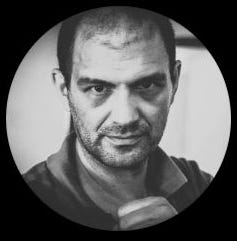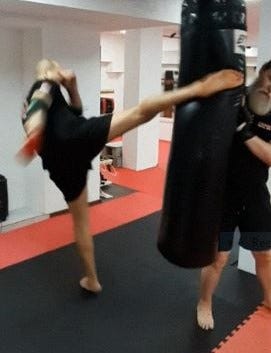553 - Srba Cvijetic / From Serbia's Football Hooligan Standoffs to the Martial Arts Mat: Lessons in Resilience and Real-World Self-Defence
A Veteran Serbian Security Officer and Martial Arts Coach shares life experiences and how survival fight training gives students self-confidence inside and outside of the training hall.
Copyright © 2025 by Jeth Randolph
All Rights Reserved.
No part of this work may be reproduced or reprinted without permission in writing from the author.
Third-party information and viewpoints do not represent my personal views or work. This is not legal advice. This content is purely educational and does not advocate for breaking any laws. Do not break any laws or regulations. Consult with your solicitor.
I’ve known my friend Srba Cvijectic for nearly two decades since the time that I lived there. Srba’s from Jagodina, Serbia, born in 1972, and his life reflects that quiet alchemy of struggle and strength. He’s also one of the most martially capable men I’ve ever met and has become a benchmark or sorts by which I compare myself and others.
From his teenage years mastering karate, kickboxing, Taekwondo, and later Wing Chun and Sanda (full contact Chinese kickboxing with takedowns and throws), to braving the raw chaos of Belgrade’s splavovi waterfront nightclubs in the nineties, casino security and guarding high-stakes lives across the Balkans, Srba has walked a path that forged a deeper understanding of resilience both in the everyday world and beyond.
His pragmatic, survival oriented outlook is very much a product of the hardships of the nineties inflicted by Leviathan’s collective punishment upon his country: economic collapse, wars and the resulting mindset and character it takes to navigate and get by in such times, something western readers may recognise and note as the clouds gather closer to home.
Last summer, we sat in the respite from the heat offered by the reception area to his S.A.M.A.S Martial Arts club in Jagodina, and he shared some experiences from his life and outlook on survival oriented martial training: working the doors in Belgrade, facing down a hundred men, coaching others seeking to stand firm in their own battles to find their fight, and also the art of transforming adversity into purpose and a philosophy of enduring—how to rise, again and again, when life tests the spirit.
Contents:
Background / influences / on conditioning / “the goal of training is to pursue a purpose” / On competition and coaching / experiences - door work in Belgrade / One hundred vs One: “I’d kill him, go for his throat and fight until I was dead.” / 'This guy caused me trouble.' / Earliest memory of experiencing physical aggression / Ah, the Eighties… / Full contact: early days in martial arts / Working in Belgrade clubs - It’s not like movies… / Keys to fighting / Advice for older trainees / Advice for solo training / Advice for female trainees facing the reality of fighting men / Are some people born with a natural instinct for fight training? / Never giving up, no matter how hard life hits / the best piece of training advice you received? / The most important quality for effective self-defence / Contact details for training in Serbia / Further reading
Background:
Srba - "I’m from Jagodina, a small city about 130 kilometres from Belgrade, born in October 1972. I started martial arts at 17, beginning with full-contact fighting, primarily karate, and later kickboxing. I also trained in Taekwondo for a couple of years, and since 2000, I’ve been practicing Kung Fu, specifically Wing Chun and Sanda. I worked as a security officer for about 15 years, including four to five years in nightclubs in Belgrade, as well as personal security and bodyguard roles, politicians, business people, casinos both here and elsewhere in the Balkans. I’ve done all three types—bouncer, security, and personal protection—and completed the IPSA course with the International Bodyguard Association.
J: Which training has had the greatest influence on your approach?
S: I love all martial arts and had the chance to train in kickboxing, full-contact fighting, and later Wing Chun and Sanda. My approach is a combination of combat sports and martial arts. Many people don’t realise there’s a difference between the two. I incorporate both, focusing on high-pressure training, cardio, heavy bag work, and pad work.
J: So, the combat sports element involves conditioning?
S: Yes, in my experience, you need that kind of training for any martial art or combat sport to be effective. Without it, there’s no logic or results. The foundation is strength, coordination, conditioning, flexibility, and explosiveness. You need to develop your body to have speed and power.
J: Does that intense conditioning deter some people?
S: It depends on the person, but the goal of training is to pursue a purpose. If the training is too tough, some people won’t step out of their comfort zone. As a coach, your job is to help them understand this over time. Most people who give up do so quickly. You need to ignite their desire to push beyond their comfort zone, because only then do you grow—not just in combat training but in any aspect of life, especially martial arts and combat sports.
J: Your training includes sports, combat sports, and a strong self-defence component, Do you have a competition-focus too like other combat sports clubs?
S: My Jagodina club is relatively new, but we’re part of the Sanda association in Serbia, and I’m on the board. Young people, like 15- or 16 year-olds, enjoy competing, so we prepare them for that. Older trainees, over 25 or 30, often don’t have the time or desire for competition but still want to train hard. I encourage those who want to push themselves, whether for competition or personal growth. I’m just the leader who opens the door. (Laughs) If someone says, 'I can’t,' I motivate them to try harder. Many live quiet lives and have never faced real pressure or stress. Training should make them stronger, more confident, and able to live better. When life knocks you down, you stand up and go one more round. (Laughs) That’s the core idea of martial arts and combat sports. Competition requires physical and mental strength, but even pure martial arts—without sparring—can leave you unprepared for self-defence after years of practice.
J: I’ve noticed that highly competitive combat sports clubs, focused on building winning teams, can push people away. Some people just want to train, while others train hard for competition. But I’ve seen coaches who make training too intense too soon, almost like a test—'Do you want to fight or not?'—and that drives people off. What are your thoughts on introducing competition too early or too intensely?
S: You can’t push too soon. Some students might have great potential but are starting from zero. If you push them too hard, you’ll scare them away, even if they could be talented. You need to go step by step. Some like being pushed, others don’t. As a coach, you must recognise this and avoid pushing someone beyond their limits too soon. Everyone has their own pace. A turtle can’t move like a rabbit, but it still reaches the finish line, just slower. Keep students happy at their own level of progress, helping them step out of their comfort zone gradually.
J: It’s the classic mistake that some coaches make of trying to force the student to learn to swim in a tsunami isn’t it? Also, when you say 'competitive,' do you mean competition within the group or in sports? I mean like a club solely focused on building a team to win competitions, to make the club look good—'My guys always win.' type crap?
S: All coaches want that, but as a teacher, your job is to help students, not to boost your own ego. A good coach wants students to surpass them. If you’re just showing off, you’re not a true teacher, no matter how skilled you are. You need to balance pushing students and being gentle, depending on what they need.
J: I remember you telling me about a particular situation in Belgrade (at a large football club that shall remain nameless…) with hooligans when you first started working security…
S: That was probably the most dangerous moment of my life. I was working security at a soccer game for a club that we won’t mention - a big club, and there was a fight in the club’s building. They sent me to investigate and write a report.
J: How old were you?
S: Around 32 or 33. It was the start of my 'new life' as part of a security team. We worked in a nightclub in Belgrade, which is very different from a small town. (Laughs) It’s intense, and I lost friends in that job—it’s dangerous. A good friend of mine was murdered by guys with a machine gun, a really bad memory.
I was sent to make a report, not knowing much about soccer fans or hooligans. When I arrived, there were about a hundred guys sitting on the floor in the building. A hundred! It was strange because I didn’t know there was a section just for these fans who were always fighting, but I found out in a hurry and they were tough to deal with.
J: So they felt they owned that building?
S: Yes, and I had no idea! I politely asked what happened. The biggest guy—huge, like 135-140 kilos, similar to someone on my crew—told me to 'Go fuck yourself.'
I said, 'Guys, I just need to write a report and leave.'
He responded with something like, 'Suck my dick.'
I stayed calm, repeating, 'I just need to make the report.'
Then he stood up, saying, 'What do you want here?' Others started jumping up, some climbing onto tables nearby.
J: They stood on the tables?
S: Yes, on the tables. There was about three meters between us, and I knew at that moment just how bad of a situation I had walked into. One older guy tried to calm things down because I didn’t know what had happened. One of them was covered in blood from the fight I was sent to investigate . Later, I learned they were fighting among themselves, even though they were part of the same crew. (Laughs) Apparently, it’s normal for them to fight and then move on, ha!
J: So it was a fight between members of the same crew?
S: Yes, and one of them even worked there! (Laughs) At that moment, I knew I was in deep trouble. You can’t stay calm if they attack. Movies where one guy fights a hundred people? That’s not real. From martial experience, some situations, you know, and talking with others who’ve been in dangerous situations, I stopped talking. Fear and adrenaline surged through me. Your brain works fast, even if you look calm outside, inside it’s a different story.
I thought, 'You’re in trouble. You might end up in the hospital or dead.'
They were drunk, maybe on drugs, possibly armed with knives. I decided if the big guy came at me, I’d kill him, go for his throat and fight until I was dead. I accepted I might die or be seriously injured, never the same again. But I kept staring at the big guy, looking fearless. (Laughs) Inside I was preparing because you are going down in any case you know, in any case you going down and that moment I was, how you say, peaceful with myself. It was visualisation you know? I accept what will happen , I accepted I would be dead or reeeally, really broken, and you’ll probably never be the same man, you know?





